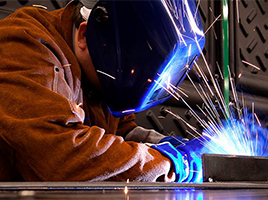Modern businesses usually rely on cybersecurity to stay protected. However, that is not enough. Physical infrastructure plays an equally vital role in overall safety and day-to-day operations. And yet, one of the most overlooked areas of physical security is also one of the most vulnerable: your doors.
According to data pulled from over 20,000 reported break-ins, front doors are the entry point in 34% of cases, followed by back doors at 22% and garage doors at 9%. That means nearly 9 out of 10 unauthorized entries happen through standard access points, not windows or obscure weak spots. This is usually seen in commercial hubs like Stockton and the greater Bay Area.
So, for business owners operating in these areas, this statistic should be a wake-up call. Having said that, let’s dive into the article for a better understanding.
The Weak Point Most Businesses Overlook
The doors are the most unseen part of the building’s safety. In fact, one doesn’t need advanced tools or hacking devices to compromise a commercial space. In many cases, a poorly secured door is all it takes.
Criminals often exploit weak framing, broken locks, or outdated materials. Some walk right in through an unlocked entrance. If your building houses sensitive information, valuable inventory, or expensive equipment, your doors should be treated as critical security assets, not afterthoughts.
Replacing or reinforcing your doors with models designed for high-traffic commercial use can stop break-ins before they start. Options like fire-rated doors, steel-reinforced doors, and galvanized models that resist rust and impact all contribute to stronger protection.
And beyond deterring intrusions, high-quality doors reduce daily frustrations. That may include:
- Less jamming,
- Fewer breakdowns, and
- Smoother flow for employees and deliveries.
Turning Entry Points into Intelligent Checkpoints
Gone are the days when locks and keys were enough. Modern doors are now an extension of your building’s digital security system. With cloud-connected hardware and smart access control tools, doors can actively improve efficiency, compliance, and safety.
Features like:
- Keycard readers.
- PIN or biometric entry systems.
- Remote lock/unlock capabilities.
- Access schedules for specific teams or vendors.
These can all be integrated into your commercial space with minimal disruption.
In fact, commercial doors in Stockton that are built with smart features can make operations a whole lot easier. With them, you need no more changing physical locks or chasing lost keys. If an employee leaves or a vendor relationship ends, you simply deactivate their access, instantly.
However, it is worth noting that businesses looking for the solution must take the help of expert professionals. One such example is GoClad. They ensure not only the right tech but proper installation. Their experience in access control, fire code compliance, and physical infrastructure helps ensure you’re secure. That, too, without slowing down operations.
Materials Make the Difference
As you already know, the doors handle a lot from weather exposure to energy costs. That’s why materials matter. No doubt, if you take the help of professionals, they will assist you in deciding. However, a general understanding beforehand will make you a better decision-maker.
Have a look below!
- Hollow metal doors are sturdy yet light enough to minimize strain on hinges.
- Galvanised steel works well for exterior doors that face rain, wind, or temperature swings.
- Fire-rated options slow flame spread and offer valuable protection during emergencies.
You can even improve natural light and visibility by choosing models with vision panels. What you have to do is just pair them with impact-rated glazing. And smart doesn’t stop at materials. Lever handles, push bars, and auto closers ensure smooth operation for both staff and visitors.
Maintenance is Equally Important
Smart doors can malfunction just like anything else. And when they do, they may create risk instead of reducing it. Even the best door system underperforms if it’s out of alignment or neglected.
Hinges that squeak or latches that misfire are more than a nuisance. In fact, they can lead to safety issues or ADA violations. Routine maintenance helps you avoid that. A few simple checks, like lubricating parts, tightening hardware, and inspecting for damage, keep doors functioning as they should.
In California, code compliance matters too. Commercial doors must meet fire safety and accessibility standards. Retrofitting with automatic openers or compliant hardware can resolve most issues without full replacements.
Conclusion
Security tech gets all the attention, but sometimes the simplest upgrades, like your doors, offer the biggest impact. When you combine durable materials with access automation and regular upkeep, your business becomes safer, more efficient, and easier to manage.
Work with teams who understand both compliance and day-to-day realities. Your entryways should do more than close securely. They should support your workflow, protect your people, and run smoothly in the background.





